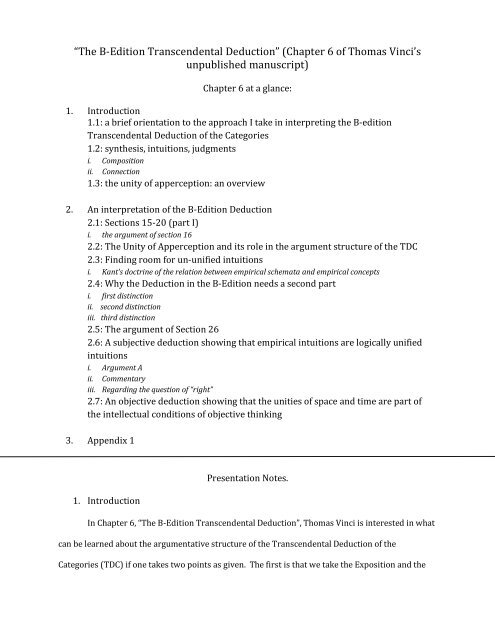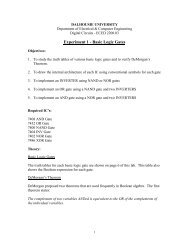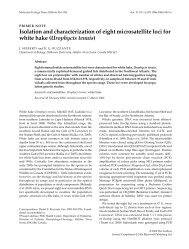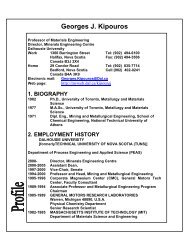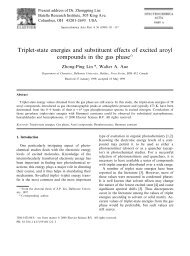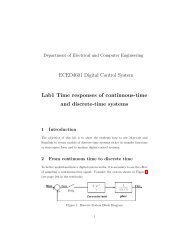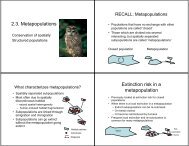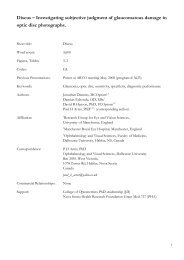Presentation notes: Vinci: Maja Jaakson - Myweb.dal.ca
Presentation notes: Vinci: Maja Jaakson - Myweb.dal.ca
Presentation notes: Vinci: Maja Jaakson - Myweb.dal.ca
You also want an ePaper? Increase the reach of your titles
YUMPU automatically turns print PDFs into web optimized ePapers that Google loves.
“The B-Edition Transcendental Deduction” (Chapter 6 of Thomas <strong>Vinci</strong>’s<br />
unpublished manuscript)<br />
Chapter 6 at a glance:<br />
1. Introduction<br />
1.1: a brief orientation to the approach I take in interpreting the B-edition<br />
Transcendental Deduction of the Categories<br />
1.2: synthesis, intuitions, judgments<br />
i. Composition<br />
ii. Connection<br />
1.3: the unity of apperception: an overview<br />
2. An interpretation of the B-Edition Deduction<br />
2.1: Sections 15-20 (part I)<br />
i. the argument of section 16<br />
2.2: The Unity of Apperception and its role in the argument structure of the TDC<br />
2.3: Finding room for un-unified intuitions<br />
i. Kant’s doctrine of the relation between empiri<strong>ca</strong>l schemata and empiri<strong>ca</strong>l concepts<br />
2.4: Why the Deduction in the B-Edition needs a second part<br />
i. first distinction<br />
ii. second distinction<br />
iii. third distinction<br />
2.5: The argument of Section 26<br />
2.6: A subjective deduction showing that empiri<strong>ca</strong>l intuitions are logi<strong>ca</strong>lly unified<br />
intuitions<br />
i. Argument A<br />
ii. Commentary<br />
iii. Regarding the question of “right”<br />
2.7: An objective deduction showing that the unities of space and time are part of<br />
the intellectual conditions of objective thinking<br />
3. Appendix 1<br />
<strong>Presentation</strong> Notes.<br />
1. Introduction<br />
In Chapter 6, “The B-Edition Transcendental Deduction”, Thomas <strong>Vinci</strong> is interested in what<br />
<strong>ca</strong>n be learned about the argumentative structure of the Transcendental Deduction of the<br />
Categories (TDC) if one takes two points as given. The first is that we take the Exposition and the
P r e s e n t a t i o n n o t e s – V i n c i C h a p t e r 6 - P a g e | 2<br />
Deduction to have similar underlying structures (as discussed in Chapter 4). The second is that the<br />
structure must accommodate interpretations of certain elements of the B-Edition 1 Transcendental<br />
Deduction’s argument. <strong>Vinci</strong>’s project is holistic: he aims at a coherent interpretation of the<br />
sections of the B-Deduction that squares with his (and Ameriks’) isomorphism thesis.<br />
Central to <strong>Vinci</strong>’s Chapter is an account of the reason for which there are two sections to the<br />
B-Deduction. In particular, <strong>Vinci</strong> argues against those who take the second part of the B-Deduction<br />
to concern empiri<strong>ca</strong>l intuitions that are merely a subspecies of the intuitions discussed in the first<br />
part, intuitions in general. Moreover, he provides an argument for the existence of un-unified<br />
intuitions. In what follows, I will present <strong>Vinci</strong>’s discussion from sections 1 to 2.3.<br />
1.2 – synthesis, intuitions, judgments<br />
Notion of synthesis compared to combination. Kant distinguishes two forms of combination<br />
(Axioms of Intuition, B-Edition):<br />
1. Composition<br />
Composition combines objects of the same nature.<br />
Problem #1: inconsistent with Kant.<br />
Problem #2: composition does not produce judgment-like wholes (and judgments are produced<br />
by synthesis) – need heterogeneous parts to the complex.<br />
2. Connection<br />
Coincides with the ontologi<strong>ca</strong>l “version” of subject-predi<strong>ca</strong>te judgments.<br />
Problem: <strong>ca</strong>nnot produce intuitions as wholes.<br />
Instead, let us consider the “Sellarsian story”<br />
• representations of properties and of objects come hand-in-hand; you <strong>ca</strong>n't have one without<br />
the other.<br />
• the objects of intuitions are objects-in-nexus-with-properties; both are complexes<br />
• However, a) the object-property complex is not given by the object (Transcendental<br />
Idealism cited); it is not given by the sensibility either (composition <strong>ca</strong>nnot combine<br />
heterogeneous parts: see Problem #2 of composition.)<br />
• Therefore: representations of object-property complexes must have come about by<br />
connection-synthesis.<br />
• These synthesized intuitions are 'judgments in disguise'.<br />
1 I refer to the A- and B-Edition Transcendental Deductions as the “A-Deduction” and “B-Deduction”<br />
respectively.
P r e s e n t a t i o n n o t e s – V i n c i C h a p t e r 6 - P a g e | 3<br />
• This is useful, <strong>Vinci</strong> maintains, be<strong>ca</strong>use we <strong>ca</strong>n account for four of the five "dogmatic<br />
assertions" Kant makes in §15 of the B-Deduction if we take combination to be connectionsynthesis.<br />
• To bridge the gap between the theory of judgment and the theory of sensibility, <strong>Vinci</strong><br />
suggests we (partly) follow Sellars, taking Kant to believe that most seeing is "seeing as."<br />
I say most seeing be<strong>ca</strong>use:<br />
Pt I of B-Deduction: concerns theory of intuitions in general<br />
Well accounted for on the Sellarsian view.<br />
Pt II of B-Deduction: theory of empiri<strong>ca</strong>l intuitions<br />
Not a subclass of intuitions in general!<br />
Hence the need for the second section.<br />
Hence the reason for which the Sellarsian story <strong>ca</strong>n’t be the whole story.<br />
***<br />
Q: How do we get a single object with characteristics C1 and C2 out of distinct, individual<br />
objectual representations?<br />
A: via logi<strong>ca</strong>l unifi<strong>ca</strong>tion, a type of composition (taking like aggregates -- representations. This<br />
is how we get “the red ball” instead of nothing but a bunch of ballish and reddish<br />
representations.<br />
The Reciprocity Thesis<br />
Part of Kant's Phenomenalist Doctrine (see Ch. 5), which explains a characteristic's inherence<br />
in an object in terms of counterfactual conditionals. . It is maintained in §17 of the B-<br />
Deduction and the A-Edition's Second Analogy.<br />
• From what I understand: laws governing a subject's experience amount to the object in<br />
question (the phenomenalist doctrine)<br />
• laws are systems of concepts (rules)<br />
• what unifies concepts (namely the unity of apperception), in turn, unifies intuitions and<br />
brings unity to objects.<br />
• Thus the unity of intuitions rests on the unity of apperception. We have seen previously (in<br />
the A-Deduction) that this rests on the unity of the understanding and, finally, on objective<br />
unity: see Strawson on objective and subjective sequences.<br />
1.3 – The Unity of Apperception: an overview<br />
This is a transitional section. However, the key to the next section is provided here: judgments are<br />
part of a synthetic conceptual ground having the characteristic of a system of general logic.<br />
What unifies judgments just is what makes my experiences mine. But the synthetic unity of<br />
apperception is not the analyti<strong>ca</strong>l unity of consciousness: this tension is addressed in section 2.1.<br />
2. An interpretation of the B-Edition Deduction<br />
2.1 – Sections 15-20 (part I)<br />
Q: Can an analytic definition of judgment be given?
P r e s e n t a t i o n n o t e s – V i n c i C h a p t e r 6 - P a g e | 4<br />
A: <strong>Vinci</strong> argues one <strong>ca</strong>nnot, be<strong>ca</strong>use it is not the <strong>ca</strong>se that all combination operations have a<br />
common element identifiable by abstraction. One may think that subject-predi<strong>ca</strong>te structure at the<br />
level of atomic propositions may provide the common element, but Kant's special "disjunctive<br />
predi<strong>ca</strong>tes" make this impossible (given his logic.)<br />
Thus, a synthetic definition of judgment is needed. This <strong>ca</strong>n be done in terms of definition with<br />
respect to a holistic body of judgments (a logi<strong>ca</strong>l system.)<br />
The argument of §16 (concerns: a) The nature of the unity of apperception; B) The nature of the self<br />
known through the unity of apperception.)<br />
• <strong>Vinci</strong> suggests we regard the "I think" as a label which may be attached to representations.<br />
Judging may be thought of as an activity ("grounding concepts") or serving as a second-order<br />
representation (to which the "I think" may be attached.) If I am right, this is related to the notion<br />
that unified intuitions are easily converted into subject-predi<strong>ca</strong>te judgments.<br />
• Thinking, then, would be done in a "language of thought" that makes use of the labels attached to<br />
different judgments as representations.<br />
• <strong>Vinci</strong> invokes the mind as a system of rule-governed judgments.<br />
Analytic unity of consciousness vs. synthetic conception ground<br />
• what makes an experience mine? It bears a certain mark (vehicle). This mark, as it is common to<br />
all of my thoughts, makes a concept of my cognitions (and not a mere conception)<br />
• But at mentioned in 1.3: it seems we are asserting and denying "mine" concepthood. This tension<br />
is created by our maintaining that what unifies judgments (a synthetic conception ground) also<br />
explains what makes my experiences mine.<br />
• <strong>Vinci</strong> proposes a solution: the concept of "mine" depends on the synthetic unity created by the<br />
mind's synthetic activity.<br />
• Turns on synthesis taking place with the appli<strong>ca</strong>tion of the "I think" label.<br />
• <strong>Vinci</strong>'s insightful suggestion: "there is no thing that all cognitions share -- but they do share a<br />
common conception" as the inputs and outputs of various logi<strong>ca</strong>l functions within the cognitive<br />
body that is the mind.<br />
The upshot:<br />
The mind attaches the "I think" label to its cognitions. The label becomes a common element (a<br />
common conception) of all cognitions: this accounts for analytic unity of consciousness. The "I<br />
think" label makes the cognitive system's self-consciousness possible.<br />
2.2 - the Unity of Apperception and its role in the argument structure of the TDC<br />
• §17 in the B-Edition features the same argument as the objective Deduction in A.<br />
• both arguments are grounded in the notion of the self as system<br />
• as objects are grounded in rule-sets concerning possible experiences of the self, a central role<br />
for the Deduction is played by the unity of apperception.<br />
In the A edition, we see that the notion of the self as a system paralleled with that of nature as a<br />
system.<br />
• While this invites an n-correlation explanation, <strong>Vinci</strong> ultimately argues there is no reason to<br />
think the unity of apperception and the unity of nature are connected by means of such an<br />
explanation in the B-Deduction.<br />
• Instead, the self as an example of a rule-governed body making knowledge of nature a "real<br />
possibility": see <strong>Vinci</strong>'s "The Schematism as Unintended Interpretation"
P r e s e n t a t i o n n o t e s – V i n c i C h a p t e r 6 - P a g e | 5<br />
Between §§17-20:<br />
• better presentation of the doctrine of the unity of apperception<br />
• important conclusion: "Thus the manifold in a given intuition also necessarily stands under<br />
the <strong>ca</strong>tegories"<br />
But <strong>Vinci</strong> argues Kant is not telling us about the nature of intuitions on the whole.<br />
• they are singular representations of an object in space and time, BUT<br />
• the phenomenalist analysis is not a universal analysis; it does not apply to all intuitions<br />
• i.e. not all intuitions represent a "set of law-like regularities governing possible sense<br />
experience"<br />
2 reasons for this. One is that there exist intuitions that do not "make explicit reference to<br />
properties which the represented object is represented as having": these are un-unified<br />
intuitions.<br />
Unlike Henrich, who maintains part II of the B-Deduction aims at showing un-unified intuitions<br />
also stand under the <strong>ca</strong>tegories, <strong>Vinci</strong> argues part II aims at showing intuitions of objects that<br />
occur in actual perception – intuitions with content, and thus, unified intuitions – stand under<br />
the <strong>ca</strong>tegories.<br />
While unified intuitions have the "seeing as" feature, un-unified ones don't.<br />
• example: apple in one's peripheral vision.<br />
A possible objection: un-unified intuitions do not exist. However, in the upcoming section, <strong>Vinci</strong><br />
argues that they do.<br />
2.3 - Finding room for un-unified intuitions<br />
Motivation for finding room for un-unified intuitions:<br />
1. the Prolegomena's judgments of perception seems to concern them<br />
2. we <strong>ca</strong>n fill in the 7-level cognition hierarchy of the Logic<br />
Q: Need we really make room? What if unified intuitions could lack the "seeing as" feature in<br />
some <strong>ca</strong>ses?<br />
A: We need to make room for them be<strong>ca</strong>use §17 of part I of the B-Deduction takes, as a<br />
premise, that intuitions in general have the feature.<br />
<strong>Vinci</strong> deals with obstacles to accepting a view allowing for un-unified intuitions:<br />
1. Unlike other commentators, he chooses to put more weight on §17 of part I of the B-<br />
Deduction and take the "seeing as" premise very seriously.<br />
2. Argument against un-unified intuitions<br />
resolution: a) the conclusion does not follow from the fourth premise (an argument required<br />
to make the step); b) Kant does not hold the first premise to be true.<br />
• Works out objection b) in this section: argues Kant does not think all intuitions are logi<strong>ca</strong>lly<br />
synthesized ones.<br />
NEW SECTION: on the Lockean reading and empiri<strong>ca</strong>l concepts vs. schemata.
P r e s e n t a t i o n n o t e s – V i n c i C h a p t e r 6 - P a g e | 6<br />
A good understanding of Kant’s theory of (perceptual) judgment, <strong>Vinci</strong> suggests, starts with<br />
understanding Kant’s position in relation to Locke’s theory of abstraction. Locke held that, having<br />
come across several particulars that resemble one another in some respect, the mind abstracts<br />
from these individuals and produces an idea. This idea is a picture; it is similar to its associated<br />
particulars, but stripped of the features that set them apart. These abstract ideas are kept in what I<br />
like to think of as a sort of mental rolodex. Every time the subject experiences sensations, the<br />
rolodex flips to the <strong>ca</strong>rd that matches up with the object sensed.<br />
While this theory seems prima facie plausible, it leads to serious problems. For instance,<br />
consider what Locke would take to be my abstract idea of a dog. This idea is supposed to resemble<br />
every dog, yet lack real dogs’ distinguishing features. But how <strong>ca</strong>n something be dog-like if it is<br />
without a particular shape, colour, size and length of coat? In fact, one would be hard-pressed to<br />
find something less dog-like than a shapeless, sizeless, colourless idea. Locke’s theory is<br />
problematic be<strong>ca</strong>use it is difficult to make sense of what the mental rolodex <strong>ca</strong>rds could possibly<br />
look like. 2<br />
Kant suggests we replace Lockean ideas with concepts. The concept of a dog is not a picture;<br />
instead, at B180, Kant says it is “a rule in accordance with which my imagination <strong>ca</strong>n specify the<br />
shape of an animal in general, without being restricted to any particular shape that experience<br />
offers me”(GW Critique 273).<br />
<strong>Vinci</strong> goes on to distinguish three things: the empiri<strong>ca</strong>l object (e.g. the dog as such),<br />
empiri<strong>ca</strong>l schema (which generates doggy pictures) and empiri<strong>ca</strong>l concept (under which every dog<br />
falls.) The empiri<strong>ca</strong>l concept of a dog produces judgments concerning the empiri<strong>ca</strong>l object, the<br />
actual dog. The empiri<strong>ca</strong>l schema of a dog, in turn, generates schematic objects; these are spatiotemporal<br />
pictures of dogs lacking the properties bestowed by the <strong>ca</strong>tegories (181). <strong>Vinci</strong> maintains<br />
schematic objects need not depend on real counterparts for their existence. For instance, pink<br />
2 For more on problems with Locke’s theory of ideas (and a non-Kantian solution to them), see Bolzano,<br />
Bernard. Theory of Science. Trans. Rolf George. Berkeley: University of California Press, 1972.
P r e s e n t a t i o n n o t e s – V i n c i C h a p t e r 6 - P a g e | 7<br />
elephants dancing on the sidewalk are schematic objects but (in ordinary circumstances) are not<br />
empiri<strong>ca</strong>l objects as they are not determined by the <strong>ca</strong>tegories.<br />
<strong>Vinci</strong> anticipates the following objection may be raised: If quantity is a <strong>ca</strong>tegory and mere<br />
appearances (schematic objects) have no <strong>ca</strong>tegory-properties, how <strong>ca</strong>n they have geometri<strong>ca</strong>l<br />
properties? He responds by saying we should take schematic objects to have quantifiable<br />
properties that do not satisfy the <strong>ca</strong>tegory of quantity and appeals to the notion of “relative<br />
quantity” (with respect to measurement.) I think a problem remains with <strong>Vinci</strong>’s response to this<br />
criticism – not for specifi<strong>ca</strong>lly geometri<strong>ca</strong>l reasons, but insofar as it seems the <strong>ca</strong>tegory of quantity<br />
plays some role in my experience of a (hallucinated) pink elephant with three spots on its forehead.<br />
***<br />
• How do we pick out schematic objects from the flurry of sense-data? <strong>Vinci</strong> reconstructs an<br />
answer to this question:<br />
1) Sense impression acquisition<br />
2) The understanding goes to work and establishes what was sensed<br />
- Runs through a schematic rolodex (as opposed to a Lockean idea one); finds<br />
match<br />
- Key: “Judging . . . is an act of synthesis matching a sense impression x with an<br />
image [schematic object] y constructed by applying a certain schema labelled S,<br />
resulting in the judgment that x is S”(185).<br />
• <strong>Vinci</strong> proposes a reading of Kant’s theory of judgment on which there are three types of<br />
unifi<strong>ca</strong>tion<br />
• Sensory unifi<strong>ca</strong>tion is not a type of synthesis on this view<br />
• At 186, a challenge is raised against <strong>Vinci</strong>’s reading; it receives a Sellarsian response<br />
Thus, <strong>Vinci</strong> concludes we have reason to believe Kant thought some intuitions are not<br />
logi<strong>ca</strong>lly synthesized. However, <strong>Vinci</strong> argues both parts I and II of the B-Deduction<br />
concern unified, not un-unified, intuitions.<br />
The aims of part II of the B-Deduction are the following:<br />
3) to provide a new transcendental argument in support of the claim that intuitions of objects<br />
"perceptually present to an observer" (i.e. intuitions of objects actually perceived) are<br />
logi<strong>ca</strong>lly, not phenomenologi<strong>ca</strong>lly, unified;<br />
4) to establish the connection between the descriptive content of part-II intuitions to the<br />
<strong>ca</strong>tegories;<br />
5) to provide a new argument for the "right" to employ <strong>ca</strong>tegories.<br />
2.4: Why the Deduction in the B-Edition needs a second part<br />
j. first distinction<br />
• <strong>ca</strong>tegori<strong>ca</strong>lly-determined judgments vs. judgments of perception<br />
ii. second distinction
P r e s e n t a t i o n n o t e s – V i n c i C h a p t e r 6 - P a g e | 8<br />
• <strong>Vinci</strong> establishes he will argue that Part I concerns intuitions subject to the <strong>ca</strong>tegories<br />
proper, while Part II concerns intuitions subject to schematized <strong>ca</strong>tegories<br />
iii. third distinction<br />
• Internal vs. external involvement of an intuition in synthetic activity<br />
• <strong>Vinci</strong> argues the intuitions discussed in Part II are “unified by internal appli<strong>ca</strong>tions of<br />
judgment”<br />
• Important for nomic prescriptivism<br />
• Key: Part I and Part II intuitions need different arguments in support of their being unified<br />
• Sense-impressions are directly relevant to establishing why Part II needs an argument that<br />
differs from the one presented in Part I: they render the first premise of <strong>Vinci</strong>’s<br />
reconstructed argument false. Deficiency of the Sellarsian story.<br />
• <strong>Vinci</strong> maintains the perception of perceptually present objects occurs by way of unified<br />
empiri<strong>ca</strong>l intuitions, not occur by way of sense impressions<br />
• <strong>Vinci</strong>’s reading provides a better understanding of Kant’s claim that the §20 conclusion is<br />
made in relation to only a partly characterized notion of empiri<strong>ca</strong>l intuition; also accounts<br />
for Kant’s claim that Part I is only a beginning.<br />
2.5: The argument of Section 26<br />
• Four themes: 1) nomic prescriptivism; 2a) synthesis of apprehension, 2b) synthesis’<br />
conformity to the unity of space and time; 3) unity present in intuitions in general<br />
transferred to empiri<strong>ca</strong>l intuitions; 4) all synthesis stands under the <strong>ca</strong>tegories.<br />
• Two arguments require reconstruction: one supporting the claim that “intuitions of<br />
perceptually present objects are intellectually unified”; another for the claim that “the<br />
unities of space and time are now part of intellectual conditions”<br />
• The A-deduction provides a guide.<br />
• Four <strong>ca</strong>usality options: <strong>Vinci</strong> prefers option D, although it too has its shortcomings.<br />
- Option D: intuitions of objects not perceptually present to us are subject to the<br />
(all) unschematized <strong>ca</strong>tegories; intuitions of perceptually present objects are<br />
subject to the schematized <strong>ca</strong>tegories of <strong>ca</strong>usality and community – to the<br />
synthetic unities of space and time.<br />
2.6: A subjective deduction showing that empiri<strong>ca</strong>l intuitions are logi<strong>ca</strong>lly unified intuitions<br />
iv. Argument A<br />
v. Commentary<br />
vi. Regarding the question of “right”<br />
2.7: An objective deduction showing that the unities of space and time are part of the<br />
intellectual conditions of objective thinking


